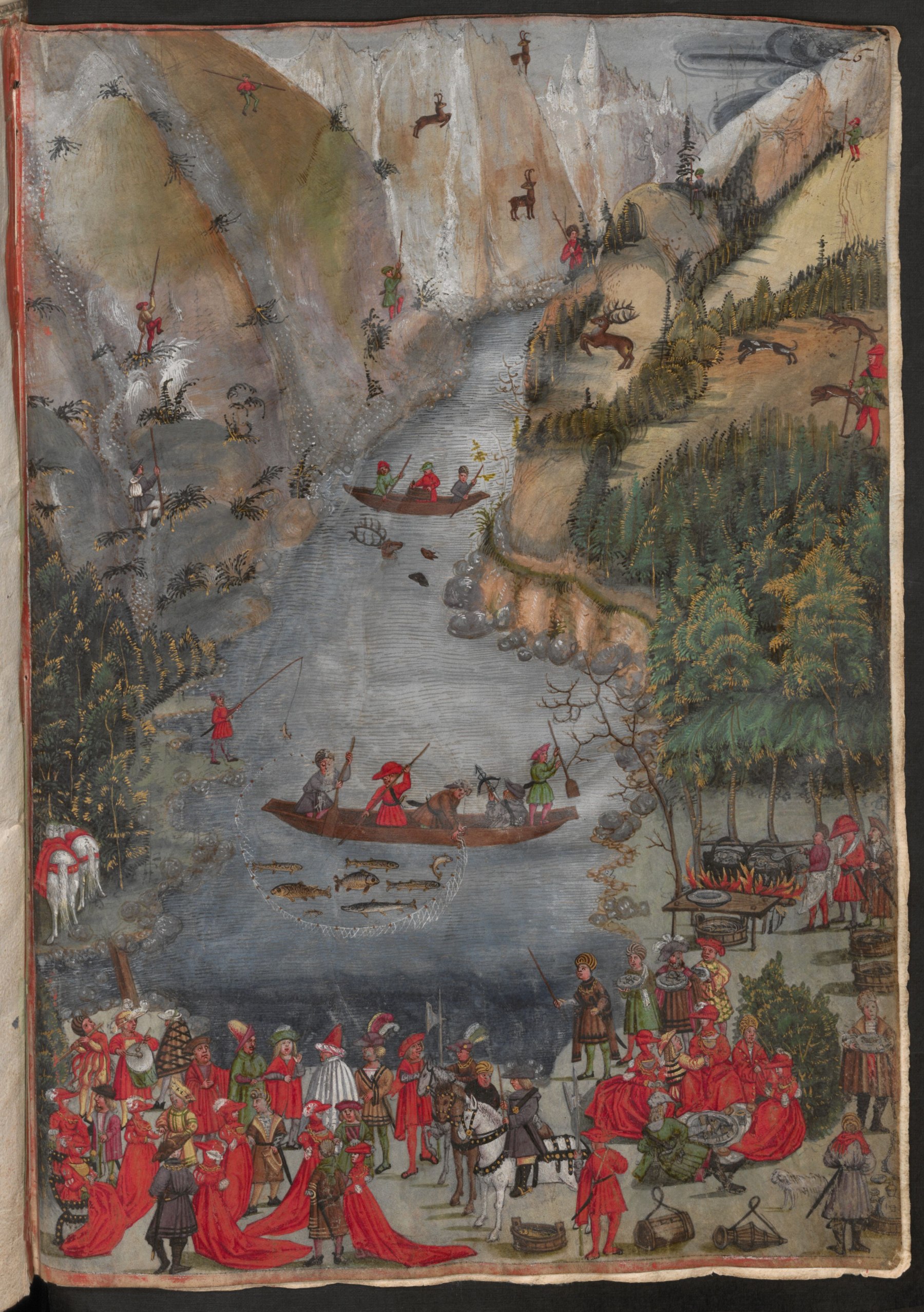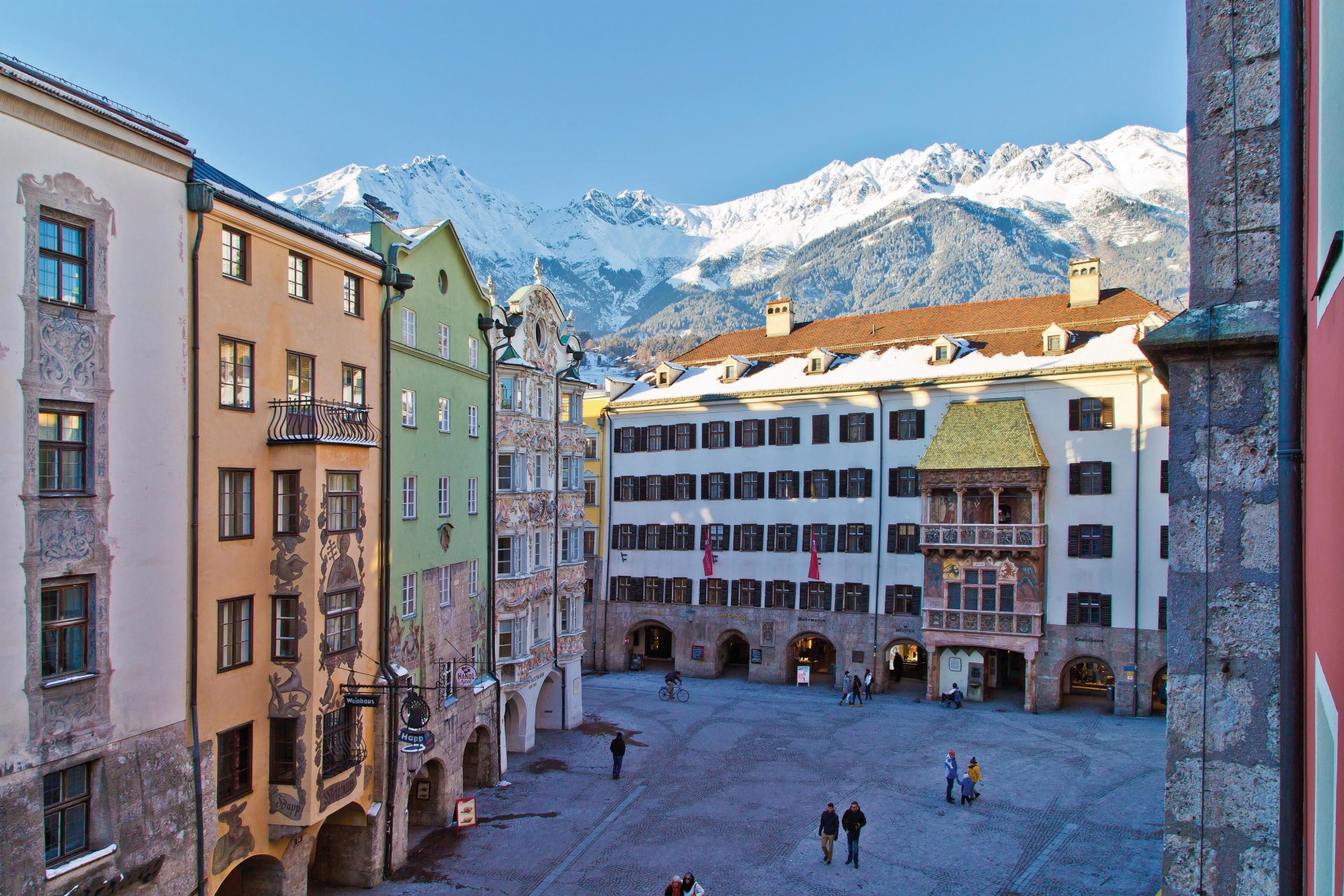Innsbruck as Residenzstadt
Innsbruck had been the seat of the Tyrolean government since 1420, when Sigmund’s father Friedrich IV of Austria, nicknamed “mit der leeren Tasche” (Frederick with the empty purse) had moved his residence to the town, constructing the palace that would remain central to the administration of ducal power for years to come. The court and palace grew in size as the dukes gained in wealth, this expansion being characteristic of the reign of Sigmund, which commenced in 1446. His income from the region’s salt and silver mines and its trade with southern Germany and Italy enabled him to develop a court of great cultural and intellectual significance, the extravagant festivities of which shaped life within his palace and the surrounding area. Sigmund, a popular figure, often participated in the celebrations of his subjects in Innsbruck or the nearby town of Hall.[11] (» D. Hofmusik. Innsbruck; » D. The Waldauf foundation.)
In the years after 1490 Maximilian developed a particular fondness for the Tyrol, which appealed to the young king on several counts: its location on the Brenner Pass meant that it was an ideal stopping point for those travelling between Italy and northern Europe; the nearby silver, copper and salt mines continued to provide a steady source of income; and the region provided the ideal surroundings for his favourite pastime of hunting (» Abb. Hunting and fishing).
Despite the king’s frequent and prolonged absences from Innsbruck, the town was not entirely without a court presence under Maximilian. While many of those employed by the royal court accompanied the monarch on his travels, other officials were permanently resident in Innsbruck, which played a crucial role as an administrative centre. And like Sigmund, Maximilian established his own residence there, in the palace which he likewise renovated and extended; the famous golden roof of the king’s treasury (added years later) is a lasting mark of Maximilian’s influence in this respect (» Abb. The Innsbruck palace with its golden roof). Yet Maximilian’s adoption of the Innsbruck palace as his main (though not permanent) residence did not mean that Sigmund was fully to relinquish his former home. Until his death in 1496, he and his wife Katharina of Saxony were to live in the “Neuhof” – the part of the palace that had been built by his father Friedrich back in 1420 – while Maximilian took up residence in the newer “Mitterhof” when visiting the region.[12]
[11] Drexel 2001, 602-3; Senn 1954, 1-2.
[12] For the Mitterhof, see » Leitbild F. with commentary. Further details of Maximilian’s relationship with Innsbruck are in Senn 1954, 19; Fritz 1968; Cuyler 1973; Benecke 1982; Wiesflecker-Friedhuber 1996 and 2005.
[1] Maximilian was elected King of the Romans in 1486. He succeeded his father, Friedrich III, as head of the House of Habsburg in 1493, but only received the title of Emperor in 1508. For clarity, he will be referred to here as king. At this time, Upper Austria (“Oberösterreich”) comprised Tyrol, parts of the Upper Rhine, East Swabia, Alsace and the Vorlande at the east end of Lake Constance: see Benecke 1982, 35; Wiesflecker-Friedhuber 1996, 131f.
[2] Benecke 1982, pp. 35-6; Wiesflecker-Friedhuber 2005, 126f.
[3] „…ihn herrlich empfienge, und unter andern Kurzweilen, zu den Tyrolischen Fundgruben führte“. Birken 1668, 1012.
[4] See, for example, Drexel 2001, 603; Höpfel 1989, 20.
[5] “Deren Gewerkleute, an der zahl 7400, unter fliegendem Fahn in schöner ordnung, ihnen entgegen kamen, und nach des Erzherzogen befehl, vor dem Röm. König sich auf die kniehe warfen.” Birken 1668, 1012f.
[6] “Sie brachten ihm auch Geschenke, etliche güldene Schüsseln voll Rheinischer Goldgulden, und ungearbeitetes Silber bey 100 Pfunde. Es kamen auch Venedische Gesandten, die ihn, mit Widergabe etlicher dem Erzhaus vordessen abgenommenen Plätze, zu versöhnen begehrten: weil sie vernommen hatten, daß sie ihn forthin zum Nachbarn haben würden.“ Birken 1668, 1012f.
[7] “Rhætica dum tellus vult se summittere Summo Æmilio, fossor prævius ecce venit. Aurea, se talem tali probat, illa, ministro: hinc auro plenas obtulit iste manûs.” Birken 1668, 1013. I would like to thank Alison Samuels for the translation of this epigram and James Robson for further advice about its meaning.
[8] “Tyrol sein Bergleut-Heer dem Helden schickt entgegen, itzt da es selbst sich will zu dessen füssen legen. Es heiset ihn willkomm durch Gold in ihrer Hand: Weil es, durch ihren Fleis, sich weist ein güldnes Land.” Birken 1668, 1012.
[9] “Aber Erzh. Sigmund, der nun ein hohes Alter auf sich, und keinen Leibs Erben mehr zuhoffen hatte, auch zu den Regirungssorgen verdrossen war, beschickte seine Landstände nach Insbruck, sprache sie ledig von ihrer Eidspflicht, und hiesse sie dem Röm. König, als ihrem angehenden Landsfürsten, schwören, den er, in ihrer gegenwart, an Sohns stat aufnahme, ihm alle von Vatter ererbte Länder abtratte und übergabe…” Birken 1668, 1013.
[10] Wiesflecker-Friedhuber 2005, 128. See also Jäger 1874.
[11] Drexel 2001, 602-3; Senn 1954, 1-2.
[12] For the Mitterhof, see » Leitbild F. with commentary. Further details of Maximilian’s relationship with Innsbruck are in Senn 1954, 19; Fritz 1968; Cuyler 1973; Benecke 1982; Wiesflecker-Friedhuber 1996 and 2005.
[13] Felix Faber (1923, 33): “In dieselbe [Innsbruck] eingetreten, fanden wir sie voll von Adeligen und Bewaffneten. Fürsten, Grafen und Barone waren zum Erzherzog gekommen, denn gerade feierte der Landesfürst mit der Tochter des Sachsenherzogs Hochzeit; zu dieser Feier war der Adel aus ganz Deutschland zusammengeströmt.”
[17] A tun of wine was awarded to the organist in January 1498: see Wiesflecker 1993, 269 (no. 5756).
[18] Wiesflecker 1993, p. 222 (no. 5364).
[19] Busch-Salmen 1992, pp. 64f.; Schuler 1995, 13.
[20] See also » I. The court chapel of Maximilian I.
[22] The Triumphzug was never completed, and its woodcut images therefore include a number of empty banners, which were to contain phrases introducing many of the personnel presented. However, the intended content of the plaques can be reconstructed from the initial manuscript programme for the images, which was dictated by Maximilian himself and refers to several musicians by name.
[24] For example, the Augsburg civic accounts of 1490 include payment of: “4 fl. des kunigs zwayen luttenschlager, Artus vnd Lenhart”. D-Asa (Stadtarchiv Augsburg), Baumeisterbücher Nr. 84 (1490), fol. 17r.
[28] Wiesflecker 1971-1986, vol. 5, 401-2.
[29] Weiss 2010, 56.
[30] Hochrinner 1966, 33-39.
[31] Archivio di Stato di Modena est disp amb germ, busta 1, undated letter, recto. A summary of the letter is presented in Regesta Imperii Online XIV,1 n. 2877: http://www.regesta-imperii.de/id/1493-12-24_1_0_14_1_0_2882_2877 (accessed 01.11.2019).
[32] Archivio di Stato di Modena est disp amb germ, busta 1, undated letter, verso. A summary of the letter is presented in Regesta Imperii Online XIV,1 n. 2877: http://www.regesta-imperii.de/id/1493-12-24_1_0_14_1_0_2882_2877 (accessed 01.11.2019). Dances at Maximilian’s court will be discussed further in » I. Civic and courtly dancing.
[33] „parte in ballare e parte in videre zugare la prefata Domina Archiducesa con alchuni altri Signori et cavaleri de li suoi et de li nostri. E queste feste qualchi volta sono facte in publico, et qualchi volta privatamente ne la camera nostra.“ Calvi 1888, 48.
[34] Tiroler Landesarchiv Innsbruck (A-Ila), Maximiliana XIV/1493, fol. 103. Summary in Regesta Imperii Online,
RI XIV,1 n. 2878: http://www.regesta-imperii.de/id/1493-12-24_2_0_14_1_0_2883_2878 (accessed 01.11.2019).
[35] Quoted in: Köfler and Caramelle 1982, 208.
[37] Regesta Imperii XIV Nr. 25967: Archivio di Stato di Mantova, Agonz, E/II/2, busta 429, Nr 6.
[38] Waldner 1897/98, 11.
[39] Waldner 1897/98, 14.
[41] Hochrinner 1966, 44.
[42] Pandolfo Collenuccio, Innsbruck, to Ercole d’Este, 18 March 1494: Archivio di Stato di Modena dis amb germ, busta 1, recto. Summary of the letter in: Regesta Imperii Online, RI XIV,1 n. 478: http://www.regesta-imperii.de/id/1494-03-16_1_0_14_1_0_482_478. See also Wiesflecker Bd. I, 368.
[43] This was Perkin Warbeck, pretender to the English throne, who claimed to be Richard, Duke of York, the missing second son of Edward IV.
[44] See Green 2012; Grassl 2019.
[46] Quoted in Meconi 2003, 27.
[47] Further on Maximilian’s chapel singers, see » I. The court chapel of Maximilian I.
[48] Waldner 1897/98, 20-21.
[49] Senn 1954, 39–44; See also Waldner 1897/98, 33–34.
[53] D-Asa (Stadtarchiv Augsburg), Baumeisterbücher Nr. 101 (1507), fol. 24v and Nr. 102 (1508), fol. 24v.
[55] Indeed, from 1516 until 1521, the two young princesses Anna of Hungary and Maria of Austria were resident at the Innsbruck palace and had several musicians in their employ. See Waldner 1897/98, 59 and Senn 1954, 46–47.
[56] Gachard 1876, 309.
[57] Gachard 1876, 310.
[58] Senn 1954, 39-40, also regarding the subsequent repair of the organ by Balthasar Streng in 1502.
[60] Gachard 1876, 319.
[61] Gachard 1876, 311.
[62] Gachard 1876, 315.
[63] Meconi 2003, 62.
[64] Gachard 1876, 313.
[65] Gachard 1876, 316–317.
[66] D-Asa (Stadtarchiv Augsburg), Baumeisterbücher Nr. 97 (1503), fol. 28r and Nr. 98 (1504), fol. 26r-v.
[67] Wessely 1956, 111.
[68] Meconi 2003, 35. See » I. Instrumentalkünstler; » G. Augustin Schubinger.
[69] Gachard 1876, 314.
[70] Gachard 1876, 320.
[71] Sanuto’s diaries are published in Barozzi 1880.
[72] Barozzi 1880, column 217.
[73] Barozzi 1880, column 216.
[74] Barozzi 1880, column 215.
[75] According to Benecke 1982, 94, Maximilian visited Innsbruck 22 times between 1498 and 1518.
Empfohlene Zitierweise:
Helen Coffey: „Music and ceremony in Maximilian’s Innsbruck“, in: Musikleben des Spätmittelalters in der Region Österreich <https://musical-life.net/essays/music-and-ceremony-maximilians-innsbruck> (2019).

